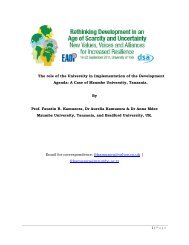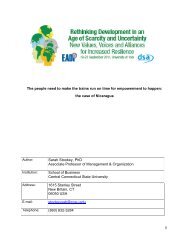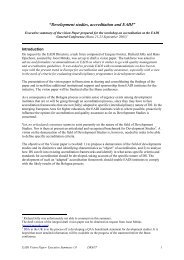Revenue Administration in Sub-Saharan Africa - International Tax ...
Revenue Administration in Sub-Saharan Africa - International Tax ...
Revenue Administration in Sub-Saharan Africa - International Tax ...
Create successful ePaper yourself
Turn your PDF publications into a flip-book with our unique Google optimized e-Paper software.
• All unified semi-autonomous revenue bodies are responsible foradm<strong>in</strong>istration of tax, customs, and other non-tax revenues.• Semi-autonomous revenue bodies are found only <strong>in</strong> Anglophone countries. 6Key observationsSurvey results <strong>in</strong>dicate that, as is the case <strong>in</strong> OECD member countries, 7 the unifiedsemi-autonomous body is the commonly observed <strong>in</strong>stitutional arrangement <strong>in</strong> thesurveyed countries. 8 In addition, the majority of semi-autonomous revenue bodieswere observed to have a governance structure compris<strong>in</strong>g of a board of directors. Inl<strong>in</strong>e with <strong>in</strong>ternational practice, these boards are vested with oversight/advisoryresponsibilities and are generally excluded by law from engag<strong>in</strong>g <strong>in</strong> taxadm<strong>in</strong>istration operational issues. 9 The pros and cons of sett<strong>in</strong>g up a semiautonomousrevenue bodies are not discussed <strong>in</strong> this series. However, it can beobserved that recent studies that have assessed the performance of semi-autonomousrevenue bodies report mixed and <strong>in</strong>conclusive f<strong>in</strong>d<strong>in</strong>gs (see Box 1 on the next page).6 Note that Rwanda was admitted to the Commonwealth Club of Nations <strong>in</strong> November 2009 while both Rwanda andBurundi are members of the East <strong>Africa</strong>n Community Common Market.7 17 out of 30 OECD member countries have established a unified semi-autonomous revenue body—Source: OECDForum on <strong>Tax</strong> <strong>Adm<strong>in</strong>istration</strong> (2009) “<strong>Tax</strong> <strong>Adm<strong>in</strong>istration</strong> <strong>in</strong> OECD and Selected Non-OECD Countries: ComparativeInformation Series (2008)”, Center for <strong>Tax</strong> <strong>Adm<strong>in</strong>istration</strong>.8 Unified semi-autonomous revenue body is def<strong>in</strong>ed to mean that the revenue adm<strong>in</strong>istration functions are carried outby a unified body that has more operational autonomy that that afforded a normal department <strong>in</strong> a m<strong>in</strong>istry. Keyareas of autonomy typically <strong>in</strong>clude human resources (recruitment, tra<strong>in</strong><strong>in</strong>g, remuneration, hir<strong>in</strong>g and fir<strong>in</strong>g),organization and plann<strong>in</strong>g, budget management, and performance standards. This model of revenue adm<strong>in</strong>istration isgenerally seen by most countries as the answer to perennial problems such as corruption, <strong>in</strong>efficient and <strong>in</strong>effectiverevenue adm<strong>in</strong>istration. (See Crandall (2010) for further def<strong>in</strong>ition/details).9 The Zambia <strong>Revenue</strong> Authority (ZRA) noted that its Board’s mandate <strong>in</strong>cludes licens<strong>in</strong>g of customs clear<strong>in</strong>g agents.The Zambia Board is therefore de facto an executive board.10





